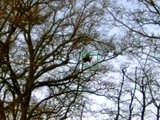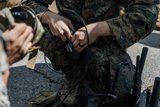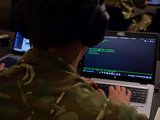NATO nations deepen cooperation on intelligence, surveillance and reconnaissance
In the spirit of "smart defence", nine Nations have launched at the end of February a five-year project that will significantly boost the Alliance's ability to tackle new challenges such as piracy by rapidly sharing imagery and other information from intelligence, surveillance and reconnaissance assets.
Under the agreement, technology that is currently being successfully used in Afghanistan will be further developed and applied in a wider context. This will make it easier and faster for Nations to share imagery from high-priced assets, such as Unmanned Aerial Vehicles, surveillance aircraft and other such assets, as and when necessary."These assets - and their deployment - are very expensive," said Lieutenant Colonel Arle Brustad of Norway, Chairman of the nine-Nation project team. "By rapidly sharing imagery, we can avoid having multiple assets deployed in the same location, cover a significantly larger area, or cover a specific area for a longer period. In effect, what we get is more intelligence for our Euro."
The project was launched in Rome in February 2011 and formally briefed to the NATO armaments and C3 community on 21 February. The level of effort will amount to over 100 million Euro and involve Industry from the nine participating Nations: Canada, France, Germany, Italy, Netherlands, Norway, Spain, the United Kingdom and the United States.
The project will also look to sharing and leveraging military assets - such as UAV imagery - in support of civilian authorities in crisis management and other roles such as border monitoring.
"We realize that many of the later developments potentially widen the applicability of the capabilities," LTC Brustad continued, "For example, military UAVs are already being used in Afghanistan to monitor progress in farming, providing key data to civilian authorities."
The Multi-intelligence All-source Joint ISR Interoperability Coalition (MAJIIC 2) succeeds the original MAJIIC, which resulted in the Alliance being able to rapidly share full motion video in Afghanistan.
"MAJIIC delivered very real benefits in Afghanistan," said Mr. Joe Ross, Technical manager for the project at the NATO Consultation, Command and Control Agency (NC3A). "For instance a commander can instantly access imagery from another Nation's UAVs, meaning that he does not have to deploy his own multi-million asset, or can deploy it in other area, allowing for the most efficient use of these expensive assets."
Similarly, because the data is labeled, stored and shared across the coalition, national intelligence analysts have far more useful material at their disposal. As an example this has significant benefits in the fight against IEDs, or drug and arms smuggling through so-called "pattern of life" analysis.
Specific benefits to NATO from the MAJIIC 2 project will include:
- Increased resource efficiency - allowing the nations to develop capabilities more quickly and operate more efficiently; to do more with less.
- Improved mission effectiveness - the ability to have timely and accurate information exchange at all levels supports more efficient and effective performance of operational tasks.
- Lower investment cost - through burden sharing during the development process, and potentially during acquisition.
- More Operationally effective utilization of technology - providing technology to support mission requirements, not just for technology's sake.
- Risk reduction to future NATO Network Enabled Capability acquisition - through a common, operationally relevant development and test-bedding concept.
"This project and its inherent benefits are very much in line with the Secretary General's call for smart defence," added LTC Brustad.
The nations have contracted technical management to the NC3A and bring to the project fielded and prototype systems along with subject matter expertise from Military, Government, and Industry staffs. The business model of MAJIIC 2 is to develop agreed standards and operational concepts as guiding requirements for national and NATO acquisitions.
Technical work has already begun, and major exercises are scheduled for 2012.
Source: NC3A
More from Digital Battlespace
-
![Chess Dynamics successfully demonstrates Vision4ce AI-driven tracker]()
Chess Dynamics successfully demonstrates Vision4ce AI-driven tracker
The Vision4ce Deep Embedded Feature Tracking (DEFT) technology software is designed to process video and images by blending traditional computer vision with artificial intelligence (AI) algorithms to present actionable information from complex environments.
-
![Wave Relay devices cleared for security use on commercial systems in industry trend]()
Wave Relay devices cleared for security use on commercial systems in industry trend
Persistent Systems has been cleared by National Security Agency (NSA) to transmit sensitive data on commercial networks. The devices are added to the NSA’s Commercial Solutions for Classified (CSfC) component list which also includes other companies’ products providing the same security.
-
![UK teases cyber spending boost in Strategic Defence Review ahead of “imminent” release]()
UK teases cyber spending boost in Strategic Defence Review ahead of “imminent” release
The release of the UK’s Strategic Defence Review (SDR) has been long promised as mid-year. It is possible it could be as early as 2 June although the UK Ministry of Defence (MoD) continues to play its cards close to its chest.
-
![Intelsat emphasises SATCOM resilience for SOF in contested domains (video)]()
Intelsat emphasises SATCOM resilience for SOF in contested domains (video)
Intelsat outlines how its multi-orbit SATCOM architecture is enhancing connectivity and resilience for special operations forces operating in degraded and contested environments.
-
![US Space Force’s next-generation missile warning system moves forward with $500 million in new contracts]()
US Space Force’s next-generation missile warning system moves forward with $500 million in new contracts
Next-Generation Overhead Persistent Infrared (Next-Gen OPIR) satellites are intended to provide early warning of missile launches from any location worldwide and new ground stations will result in expanded coverage of critical missile warning.
























